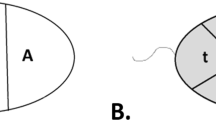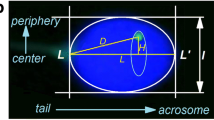Abstract
Purpose
The study aims to determine whether there is an altered bivalent positioning in metaphase I human spermatocytes from Robertsonian translocation carriers.
Methods
Metaphase I human spermatocytes from three 45,XY,der(13;14)(q10;q10) individuals and a 45,XY,der(14;15)(q10;q10) individual were analyzed. Proximity relationships of bivalents were established by analyzing meiotic preparations combining Leishman staining and multiplex-FISH procedures. Poisson regression model was used to determine proximity frequencies between bivalents and to assess associations with chromosome size, gene density, acrocentric morphology, and chromosomes with heterochromatic blocks. The hierarchical cluster Ward method was used to characterize the groups of bivalents with preferred proximities in a cluster analysis. Bivalent groups obtained were individually compared with those obtained in normal karyotype individuals evaluated in a previous study.
Results
A total of 1288 bivalents were examined, giving a total of 2289 proximity data. Only four positive significant proximities were detected for each type of Robertsonian translocation. Significant bivalent associations were only observed by small-size chromosomes for MI,22,XY,III(13q14q). These results were clearly divergent from 46,XY individuals. Moreover, cluster analysis revealed that about 30 % of the bivalents showed changes in their proximity relationships in metaphase I.
Conclusions
The territorial organization of bivalents in metaphase I human spermatocytes changes in the presence of a Robertsonian translocation.


Similar content being viewed by others
References
Cremer T, Cremer M. Chromosome territories. Cold Spring Harb Perspect Biol. 2010;2:a003889.
Cremer M, von Hase J, Volm T, Brero A, Kreth G, Walter J, et al. Non-random radial higher-order chromatin arrangements in nuclei of diploid human cells. Chromosom Res. 2001;9:541–67.
Boyle S, Gilchrist S, Bridger JM, Mahy NL, Ellis JA, Bickmore WA. The spatial organization of human chromosomes within the nuclei of normal and emerin-mutant cells. Hum Mol Genet. 2001;10:211–9.
Küpper K, Kölbl A, Biener D, Dittrich S, von Hase J, Thormeyer T, et al. Radial chromatin positioning is shaped by local gene density, not by gene expression. Chromosoma. 2007;116:285–306.
Hübner MR, Spector DL. Chromatin dynamics. Annu Rev Biophys. 2010;39:471–89.
Sun HB, Shen J, Yokota H. Size-dependent positioning of human chromosomes in interphase nuclei. Biophys J. 2000;79:184–90.
Parada LA, McQueen PG, Misteli T. Tissue-specific spatial organization of genomes. Genome Biol. 2004;5:R44.
Zeitz MJ, Marella NV, Malyavantham KS, Goetze S, Bode J, Raska I, et al. Organization of the amplified type I interferon gene cluster and associated chromosome regions in the interphase nucleus of human osteosarcoma cells. Chromosom Res. 2009;17:305–19.
Cremer T, Cremer M, Dietzel S, Müller S, Solovei I, Fakan S. Chromosome territories—a functional nuclear landscape. Curr Opin Cell Biol. 2006;18:307–16.
Cavalli G. Chromosome kissing. Curr Opin Genet Dev. 2007;17:443–50.
Hübner MR, Eckersley-Maslin MA, Spector DL. Chromatin organization and transcriptional regulation. Curr Opin Genet Dev. 2013;23:89–95.
Nguyen HQ, Bosco G. Gene positioning effects on expression in eukaryotes. Annu Rev Genet. 2015;49:627–46.
Cremer M, Küpper K, Wagler B, Wizelman L, von Hase J, Weiland Y, et al. Inheritance of gene density-related higher order chromatin arrangements in normal and tumor cell nuclei. J Cell Biol. 2003;162:809–20.
Li C, Shi Z, Zhang L, Huang Y, Liu A, Jin Y, et al. Dynamic changes of territories 17 and 18 during EBV-infection of human lymphocytes. Mol Biol Rep. 2010;37:2347–54.
Meaburn KJ, Cabuy E, Bonne G, Levy N, Morris GE, Novelli G, et al. Primary laminopathy fibroblasts display altered genome organization and apoptosis. Aging Cell. 2007;6:139–53.
Gerlich D, Ellenberg J. Dynamics of chromosome positioning during the cell cycle. Curr Opin Cell Biol. 2003;15:664–71.
Walter J, Schermelleh L, Cremer M, Tashiro S, Cremer T. Chromosome order in HeLa cells changes during mitosis and early G1, but is stably maintained during subsequent interphase stages. J Cell Biol. 2003;160:685–97.
Thomson I, Gilchrist S, Bickmore WA, Chubb JR. The radial positioning of chromatin is not inherited through mitosis but is established de novo in early G1. Curr Biol. 2004;14:166–72.
Codina-Pascual M, Navarro J, Oliver-Bonet M, Kraus J, Speicher MR, Arango O, et al. Behaviour of human heterochromatic regions during the synapsis of homologous chromosomes. Hum Reprod. 2006;21:1490–7.
Sarrate Z, Blanco J, Vidal F. Acrocentric bivalents positioned preferentially nearby to the XY pair in metaphase I human spermatocytes. Fertil Steril. 2012;98:1241–5.
Vergés L, Blanco J, Valero O, Vidal F, Sarrate Z. Chromosome size, morphology, and gene density determine bivalent positioning in metaphase I human spermatocytes. Fertil Steril. 2014;101:818–24.
Hazzouri M, Rousseaux S, Mongelard F, Usson Y, Pelletier R, Faure AK, et al. Genome organization in the human sperm nucleus studied by FISH and confocal microscopy. Mol Reprod Dev. 2000;55:307–15.
Zalenskaya IA, Zalensky AO. Non-random positioning of chromosomes in human sperm nuclei. Chromosom Res. 2004;12:163–73.
Foster HA, Abeydeera LR, Griffin DK, Bridger JM. Non-random chromosome positioning in mammalian sperm nuclei, with migration of the sex chromosomes during late spermatogenesis. J Cell Sci. 2005;118:1811–20.
Ioannou D, Meershoek EJ, Christopikou D, Ellis M, Thornhill AR, Griffin DK. Nuclear organisation of sperm remains remarkably unaffected in the presence of defective spermatogenesis. Chromosom Res. 2011;19:741–53.
Mudrak OS, Nazarov IB, Jones EL, Zalensky AO. Positioning of chromosomes in human spermatozoa is determined by ordered centromere arrangement. PLoS One. 2012;7(12):e52944.
Greaves IK, Rens W, Ferguson-Smith MA, Griffin D, Graves JAM. Conservation of chromosome arrangement and position of the X in mammalian sperm suggests functional significance. Chromosom Res. 2003;11:503–12.
Zalensky A, Zalenskaya I. Organization of chromosomes in spermatozoa: an additional layer of epigenetic information? Biochem Soc Trans. 2007;35:609–11.
Gardner R, Sutherland G, Shaffer L. Chromosome abnormalities and genetic counseling. New York: Oxford University Press; 2011.
Mau-Holzmann UA. Somatic chromosomal abnormalities in infertile men and women. Cytogenet Genome Res. 2005;111:317–36.
Burgoyne PS, Mahadevaiah SK, Turner JMA. The consequences of asynapsis for mammalian meiosis. Nat Rev Genet. 2009;10:207–16.
Garagna S, Zuccotti M, Thornhill A, Fernandez-donoso R, Berrios S, Capanna E, et al. Alteration of nuclear architecture in male germ cells of chromosomally derived subfertile mice. 2001;4429–34.
Wiland E, Zegało M, Kurpisz M. Interindividual differences and alterations in the topology of chromosomes in human sperm nuclei of fertile donors and carriers of reciprocal translocations. Chromosom Res. 2008;16:291–305.
Acloque H, Bonnet-Garnier A, Mompart F, Pinton A, Yerle-Bouissou M. Sperm nuclear architecture is locally modified in presence of a Robertsonian translocation t(13;17). PLoS One. 2013;8:e78005.
WHO laboratory manual for the examination of human semen and sperm-cervical mucus interaction. 4th ed. New York: Cambridge University Press; 1999.
Templado C, Marina S, Coll MD, Egozcue J. Meiotic studies in human semen. Report of 180 cases. Hum Genet. 1980;53:335–9.
Sarrate Z, Blanco J, Egozcue S, Vidal F, Egozcue J. Identification of meiotic anomalies with multiplex fluorescence in situ hybridization: Preliminary results. Fertil Steril. 2004;82:712–7.
Cameron AC, Trivedi PK. Regression analysis of count data. 1998. Cambridge: University Press; 1998. p. 411.
Cox TF, Cox MAA. Multidimensional scaling, 2nd ed. CRC Press; 2000.
Luciani JM, Guichaoua MR, Mattei A, Morazzani MR. Pachytene analysis of a man with a 13q;14q translocation and infertility. Behavior of the trivalent and nonrandom association with the sex vesicle. Cytogenet Cell Genet. 1984;38:14–22.
Guichaoua MR, Quack B, Speed RM, Noel B, Chandley AC, Luciani JM. Infertility in human males with autosomal translocations: meiotic study of a 14;22 Robertsonian translocation. Hum Genet. 1990;86:162–6.
Navarro J, Vidal F, Benet J, Templado C, Marina S, Egozcue J. XY-trivalent association and synaptic anomalies in a male carrier of a Robertsonian t(13;14) translocation. Hum Reprod. 1991;6:376–81.
Sciurano R, Rahn M, Rey-Valzacchi G, Solari AJ. The asynaptic chromatin in spermatocytes of translocation carriers contains the histone variant gamma-H2AX and associates with the XY body. Hum Reprod. 2007;22:142–50.
Sciurano RB, Rahn MI, Rey-Valzacchi G, Coco R, Solari AJ. The role of asynapsis in human spermatocyte failure. Int J Androl. 2012;35:541–9.
Kirkpatrick G, Ren H, Liehr T, Chow V, Ma S. Meiotic and sperm aneuploidy studies in three carriers of Robertsonian translocations and small supernumerary marker chromosomes. Fertil Steril. 2015;103:1162–9.e7.
Homolka D, Ivanek R, Capkova J, Jansa P, Forejt J. Chromosomal rearrangement interferes with meiotic X chromosome inactivation. Genome Res. 2007;17:1431–7.
de Laat W, Grosveld F. Inter-chromosomal gene regulation in the mammalian cell nucleus. Curr Opin Genet Dev. 2007;17:456–64.
Armstrong SJ, Goldman AS, Speed RM, Hultén MA. Meiotic studies of a human male carrier of the common translocation, t(11;22), suggests postzygotic selection rather than preferential 3:1 MI segregation as the cause of liveborn offspring with an unbalanced translocation. Am J Hum Genet. 2000;67:601–9.
Pigozzi MI, Sciurano RB, Solari AJ. Changes in crossover distribution along a quadrivalent in a man carrier of a reciprocal translocation t(11;14). Biocell. 2005;29:195–203.
Ferguson KA, Chow V, Ma S. Silencing of unpaired meiotic chromosomes and altered recombination patterns in an azoospermic carrier of a t(8;13) reciprocal translocation. Hum Reprod. 2008;23:988–95.
Leng M, Li G, Zhong L, Hou H, Yu D, Shi Q. Abnormal synapses and recombination in an azoospermic male carrier of a reciprocal translocation t(1;21). Fertil Steril. 2009;91:1293. e17–22.
Laurie DA, Palmer RW, Hultén MA. Studies on chiasma frequency and distribution in two fertile men carrying reciprocal translocations; one with a t(9;10) karyotype and one with a t(Y;10) karyotype. Hum Genet. 1984;68:235–47.
Goldman AS, Martin RH, Johannisson R, Gould CP, Davison EV, Emslie JE, et al. Meiotic and sperm chromosome analysis in a male carrier of an inverted insertion (3;10)(q13.2;p14p13). J Med Genet. 1992;29:460–4.
Oliver-Bonet M, Navarro J, Codina-Pascual M, Abad C, Guitart M, Egozcue J, et al. From spermatocytes to sperm: meiotic behaviour of human male reciprocal translocations. Hum Reprod. 2004;19:2515–22.
Sarrate Z, Vidal F, Blanco J. Meiotic abnormalities in metaphase I human spermatocytes from infertile males: frequencies, chromosomes involved, and the relationships with polymorphic karyotype and seminal parameters. Asian J Androl 16:838–44.
McStay B, Grummt I. The epigenetics of rRNA genes: from molecular to chromosome biology. Annu Rev Cell Dev Biol. 2008;24:131–57.
Acknowledgments
This study was supported by the Project 2014SGR-524 (Generalitat de Catalunya, Spain) and Project CF-180034 (Universitat Autònoma de Barcelona, Spain). The authors thank the Hospital Clínic de Barcelona and Instituto de Reproducción CEFER for providing biological samples of the patients analyzed. We also thank the Statistical Service of the Universitat Autònoma de Barcelona for its support in the statistical treatment of the results. This manuscript has been proofread by Proof-Reading-Service.org.
Author information
Authors and Affiliations
Corresponding author
Ethics declarations
Patients gave their informed consent with regard to the participation in the study, and protocols were approved by our Institutional Ethics Committee.
Additional information
Capsule The territorial organization of bivalents in metaphase I human spermatocytes changes in the presence of a Robertsonian translocation.
Appendix
Appendix
Rights and permissions
About this article
Cite this article
Solé, M., Blanco, J., Valero, O. et al. Altered bivalent positioning in metaphase I human spermatocytes from Robertsonian translocation carriers. J Assist Reprod Genet 34, 131–138 (2017). https://doi.org/10.1007/s10815-016-0809-y
Received:
Accepted:
Published:
Issue Date:
DOI: https://doi.org/10.1007/s10815-016-0809-y




